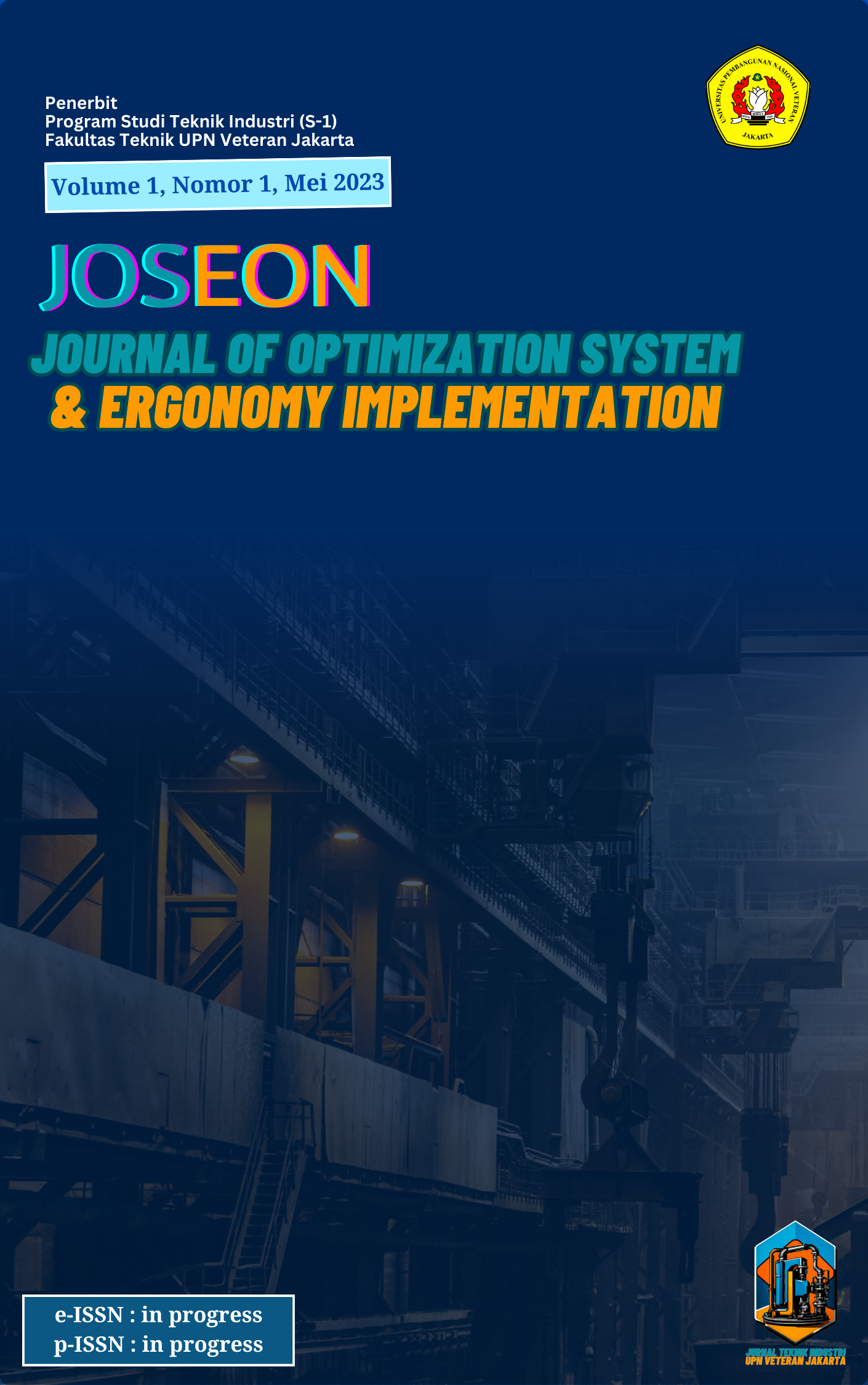The Workload Analysis to Determine Optimal Workforce in Employees at PT IJI
DOI:
https://doi.org/10.54378/joseon.v1i1.7440Keywords:
Workload, MFTE, Work Sampling, Tenaga Kerja OptimalAbstract
PT IJI is a company that operates in the field of outsource facility services, trade, and technology, one of its projects is at Mall Kalibata City. During the course of the project there were some problems such as the monthly activity plan (RKB) that had been drawn up by the team was not implemented according to the schedule. This is because of the shortage of labor and the workload received by the workers on this project is excessive. Thus, the measurement of the workload as the basis for determining the optimum workforce needs should be done. In this study, using the Modified Full Time Equivalent (MFTE) method to identify the amount of workload received by the worker and determine the optimum workforce. The results of the calculation of the MFTE method, the whole worker as the object of this study had overload with an average value of MFTE of 2.27 (overload) and was given a proposal with an addition of the workforce of 15 people and the size of the value MFTE after the proposal of the improvement of the average workload to 1.14 (fit).
References
Agung, A. A. P., & Yuesti, A. (2017). Metodologi Penelitian Kuantitatif dan Kualitatif.
Amri, A., Irwansyah, D., & Yulisa, Y. (2018). Arrnalisis Kebutuhan Jumlah Tenaga Kerja Berdasarkan Metode Work Load Analysis Dan Work Force Analysis. Industrial Engineering Journal, 7(1).
Andriani, D. P., Anugrah, B., & Islami, A. D. (2017). Aplikasi Metode Work Sampling untuk Menghitung Waktu Baku dan Kapasitas Produksi pada Industri Keramik.
Anggraini, R., Laorenza, S., & Adelino, M. I. (2023). Analisis Pengukuran Waktu Kerja Secara Langsung Dengan Metode Work Sampling Pada UMKM Soerabi Bandung. Jurnal Sains dan Teknologi (JSIT), 3(1), 151-157.
Budaya, P. W., & Muhsin, A. (2018). Workload analysis in quality control department. Opsi, 11(2), 134-140.
Cahyaningrum, D. T., Siswanto, N., & Firmanto, H. (2021). Penentuan Tenaga Kerja Optimal pada Packaging Kopi dengan Menggunakan Analisis Beban Kerja Metode Work Sampling. Jurnal Ilmiah Inovasi, 21(1), 46-49.
Diniaty, D., & Ariska, I. (2017). Penentuan Jumlah Tenaga Kerja Berdasarkan Waktu Standar Dengan Metode Work Sampling Di Stasiun Repair Overhoul Gearbox. Jurnal Teknik Industri, 3(1).
Erliana, C. I. (2015). Bahan Ajar Analisa dan Pengukuran Kerja. JURUSAN TEKNIK INDUSTRI FAKULTAS TEKNIK UNIVERSITAS MALIKUSSALEH.
Ernawati, R., & Fauziyyah, H. L. (2022). Penentuan Jumlah Tenaga Kerja Optimal Berdasarkan Beban Kerja Pada Pt X. Jurnal Industri dan Teknologi Samawa, 3(2), 110-116.
Injavira, A. (2022). ANALISIS BEBAN KERJA MELALUI METODE FULL TIME EQUIVALENT UNTUK MENGOPTIMALKAN KINERJA PEGAWAI DINAS KEPENDUDUKAN DAN PENCATATAN SIPIL KOTA MADIUN. Jurnal Ekonomi dan Bisnis (EK dan BI), 5(1), 29-35.
Kusuma, T. Y. T., & Firdaus, M. F. S. (2019). Penentuan Jumlah Tenaga Kerja Optimal untuk Peningkatan Produktifitas Kerja (Studi Kasus: UD. Rekayasa Wangdi W). Integrated Lab Journal, 7(2), 26-36.
Lestari, P., & Trisyulianti, E. (2018). Analisis Beban Kerja dan Kebutuhan Karyawan (Direktorat Operasional Kantor Pusat) PT Perkebunan Nusantara VIII. Jurnal Manajemen dan Organisasi, 9(3), 182-191.
Muzakir, M., Irawan, H. T., & Pamungkas, I. (2019). Pengukuran waktu kerja karyawan bengkel Toyota PT. Dunia Barusa di kota Banda Aceh. Jurnal Optimalisasi, 4(1), 21-29.
Mahawati, E., Yuniwati, I., Ferinia, R., Rahayu, P. F., Fani, T., Sari, A. P., ... & Bahri, S. (2021). Analisis Beban Kerja dan produktivitas kerja.
Pradana, A. Y., & Pulansari, F. (2021). Analisis pengukuran waktu kerja dengan stopwatch time study untuk meningkatkan target produksi di PT. XYZ. JUMINTEN, 2(1), 13-24.
Prima, A. A., & Izzati, T. (2018). Analisis Beban Kerja Terhadap Tenaga Kerja Analis Kimia Dengan Metode Full Time Equivalent Di Divisi Technology Development Departemen R&D-Analytical Development Pt Xyz. Penelitian dan Aplikasi Sistem dan Teknik Industri, 12(2), 328340.
Putrisani, F. S., Nugraha, A. E., & Herwanto, D. (2023). Analisis Kelelahan Kerja Subjektif dengan Menggunakan Kuesioner Subjective Self Rating Test. STRING (Satuan Tulisan Riset dan Inovasi Teknologi), 7(3), 258-266.
Rachmuddin, Y., Dewi, D. S., & Dewi, R. S. (2021, February). Workload analysis using Modified Full Time Equivalent (M-FTE) and NASA-TLX methods to optimize engineer headcount in the engineering services department. In IOP Conference Series: Materials Science and Engineering (Vol. 1072, No. 1, p. 012036). IOP Publishing
Sari, A. D., Hardiansa, F., & Suryoputro, M. R. (2018). Workload assessment on foundry SME to enhance productivity using full time equivalent. In MATEC Web of Conferences (Vol. 154, p. 01081). EDP Sciences
Septiani, N. U., & Nurbani, S. N. (2022). Penggunaan Metode Work Sampling untuk Menganalisis Produktivitas Tenaga Kerja Operator Sewing di CV ABC. Rekayasa Industri dan Mesin (ReTIMS), 3(2), 71-76.
Yasra, R., & Sahril, M. (2019). PENETAPAN WAKTU STANDAR OPERATOR PELAYANAN PENGISIAN BBM DENGAN MENGGUNAKAN METODE WORK SAMPLING.(STUDI KASUS DI PT. PERTAMINA RETAIL SPBU COCO SEILADI BATAM). Jurnal Industri Kreatif (JIK), 3(01), 79-88.
Downloads
Published
How to Cite
Issue
Section
License
Copyright (c) 2024 Journal of Optimization System and Ergonomy Implementation

This work is licensed under a Creative Commons Attribution-NonCommercial-ShareAlike 4.0 International License.











